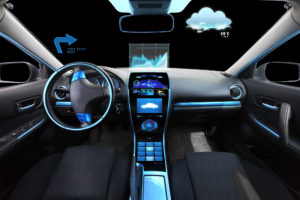Automotive Applications for Embedded Vision
Vision products in automotive applications can make us better and safer drivers
Vision products in automotive applications can serve to enhance the driving experience by making us better and safer drivers through both driver and road monitoring.
Driver monitoring applications use computer vision to ensure that driver remains alert and awake while operating the vehicle. These systems can monitor head movement and body language for indications that the driver is drowsy, thus posing a threat to others on the road. They can also monitor for driver distraction behaviors such as texting, eating, etc., responding with a friendly reminder that encourages the driver to focus on the road instead.
In addition to monitoring activities occurring inside the vehicle, exterior applications such as lane departure warning systems can use video with lane detection algorithms to recognize the lane markings and road edges and estimate the position of the car within the lane. The driver can then be warned in cases of unintentional lane departure. Solutions exist to read roadside warning signs and to alert the driver if they are not heeded, as well as for collision mitigation, blind spot detection, park and reverse assist, self-parking vehicles and event-data recording.
Eventually, this technology will to lead cars with self-driving capability; Google, for example, is already testing prototypes. However many automotive industry experts believe that the goal of vision in vehicles is not so much to eliminate the driving experience but to just to make it safer, at least in the near term.

Future Automotive Technologies Represent a US$1.6 Trillion Opportunity in 2034
For more information, visit https://www.idtechex.com/en/research-report/future-automotive-technologies-2024-2034-applications-megatrends-forecasts/979. The automotive megatrends that will define the future of vehicles: autonomous driving, mobility as a service, electric vehicles, connected cars, software-defined vehicles, everything-as-a-service, and more. Autonomous driving technologies and vehicle electrification are megatrends that are reshaping the automotive industry. In addition to these, connected and software defined vehicles have recently

What’s In the Box? In-cabin Monitoring Systems At a Glance
This market research report was originally published at the Yole Group’s website. It is reprinted here with the permission of the Yole Group. Twice a month, Yole SystemPlus analysts share noteworthy points from their automotive Teardown Tracks. Today, they take us to the heart of imaging-based occupant and driver monitoring systems (OMS and DMS). Already

What’s In the Box? Automotive LiDARs At a Glance
This market research report was originally published at the Yole Group’s website. It is reprinted here with the permission of the Yole Group. Twice a month, Yole SystemPlus analysts share the noteworthy points from their automotive Teardown Tracks. Today, Benjamin Pussat, Technology & Cost Analyst at Yole SystemPlus, takes us to the heart of LiDAR

What’s In the Box? Automotive Radars At a Glance
This market research report was originally published at the Yole Group’s website. It is reprinted here with the permission of the Yole Group. 3D waveguide antenna technology constitutes a revolution. Twice a month, Yole SystemPlus analysts share the noteworthy points from their automotive Teardown Tracks. Today, Baptiste Desbois, Guillaume Robichon, Maël Fontaine, Stéphane Elisabeth, Technology

What’s In the Box? Driver Monitoring Systems in Chinese Cars At a Glance
This market research report was originally published at the Yole Group’s website. It is reprinted here with the permission of the Yole Group. DMS rely on a simple optical architecture, low resolution and old CIS technologies Twice a month, Yole SystemPlus analysts share the noteworthy points from their automotive Teardown Tracks. Today, Arnaud Morillon, Baptiste

D3 Announces Production-intent mmWave Radar Kit Based on Texas Instruments Radar Sensor
Based on Texas Instruments mmWave radar technology, the DesignCore® RS-2944A mmWave Radar Sensor features a single board, small form factor, and an easy-to-use USB-serial interface. Rochester, NY – December 19, 2023 – D3, announced their DesignCore® RS-2944A mmWave Radar Sensor Evaluation Kit based on TI’s AWR2944 radar sensor. The DesignCore Evaluation Kit enables the implementation

New Partnership Agreement Between Outsight and Innovusion
The goal of this new partnership is focused on accelerating LiDAR technology in the ITS market. Outsight, a specialist in 3D Spatial Intelligence Software Solutions, and Innovusion, a leading provider of advanced, high-performance LiDAR systems, today announced a new partnership aiming to combine Outsight’s software platform with Innovusion’s products. Thanks to this partnership, 3D perception

The Automotive Industry: A 2023 Review and 2024 Expectations
This market research report was originally published at the Yole Group’s website. It is reprinted here with the permission of the Yole Group. Yole Group predicts a rise in sensor content per vehicle. However, is Europe hindered by its emphasis on electrification? As we approach the end of 2023, Yole Group’s analysts contemplate the factors

What, or Who, is a Safe Bet in ADAS in 2024?
This market research report was originally published at the Yole Group’s website. It is reprinted here with the permission of the Yole Group. For sure, sensor content per vehicle will increase, announces Yole Group. But will Europe be held back by its focus on electrification? As 2023 draws to a close, Yole Group’s analysts reflect

e-con Systems Demonstration of a 360 Degree Bird Eye View Camera for Autonomous Mobility
Laxman Sankaran, Director of US Operations, and Vinoth Rajagopalan, Project Engineering Manager, both of e-con Systems, demonstrate the company’s latest edge AI and vision technologies and products at the December 2023 Edge AI and Vision Alliance Forum. Specifically, Sankaran and Rajagopalan demonstrate the company’s ArniCAM20, a 360-degree bird-eye-view synchronized multi-camera solution. This multi-camera solution comprises

